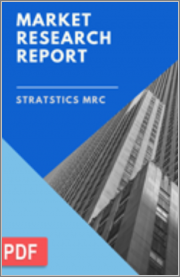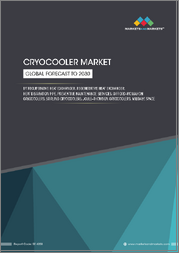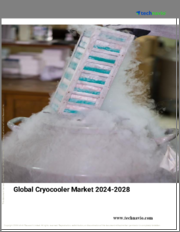
|
시장보고서
상품코드
1383461
세계의 초전도체용 크라이오쿨러 시장 전망(-2030년) : 유형별, 용도별 및 지역별 분석Cryocooler for Superconductor Market Forecasts to 2030 - Global Analysis By Type, Application and by Geography |
||||||
Stratistics MRC에 따르면, 초전도체용 크라이오쿨러 세계 시장은 예측 기간 동안 8.7%의 CAGR을 나타낼 것으로 예상됩니다.
초전도 재료는 일반적으로 극저온 냉각 장치라고 불리는 중요한 냉각 장치를 사용하여 전기 저항이 0이 되는 온도 이하의 극저온으로 유지됩니다. 또한, 이 작은 장치들은 스털링 장치, 기포드 맥마흔 사이클 등 다양한 기술을 사용하여 열을 효율적으로 제거하여 초전도체를 냉각시킵니다. 이를 통해 MRI 장비, 입자 가속기, 양자 컴퓨팅 등의 장비의 초전도체가 안정적인 에너지 효율로 작동할 수 있도록 합니다.
Proof point의 보고서에 따르면, 내부자 위협으로 인한 평균 비용은 1,538만 달러로 연간 34%의 기업에 영향을 미치고 있습니다. 악의적인 내부자는 조직의 시스템과 프로세스에 익숙하기 때문에 보안 조치를 발견되지 않고 통과하기 쉬우며, 이는 종종 그들에게 유리하게 작용합니다.
초전도 기술 개발
초전도 재료는 새로운 고온 초전도체 발견을 포함한 지속적인 연구 개발 노력으로 새로운 실용적인 용도를 찾고 있습니다. 과학 연구, 에너지 저장, 발전 및 운송은 모두 이러한 재료를 사용합니다. 또한 이러한 응용 분야의 효과적인 기능은 초전도체를 임계 저온으로 유지하는 데 필수적인 극저온 냉각기에 의해 실현되고 있습니다.
높은 초기비용
크라이오쿨러, 특히 초전도 응용 분야에 사용되는 크라이오쿨러의 구매, 설치 및 유지보수에는 많은 초기 비용이 발생할 수 있습니다. 일부 잠재적 사용자, 특히 예산이 부족한 분야에서는 이 점을 꺼려할 수 있습니다. 또한, 극저온 냉각 시스템의 채택은 초기 비용으로 인해 제한을 받을 수 있습니다.
양자기술의 발전
양자컴퓨팅과 양자통신 관련 기술은 발전하고 있을 뿐만 아니라 기업 및 학계가 쉽게 이용할 수 있게 되었습니다. 이러한 양자 기술의 핵심인 초전도 양자 비트는 높은 냉각 요구 사항을 가지고 있습니다. 이번 확장으로 크라이오쿨러 제조업체는 이러한 요구 사항을 충족시킬 수 있는 기회를 얻게 되었습니다. 또한, 양자 응용이 실험 단계에서 상업화 단계에 접어들면서 초저온을 장시간 유지하기 위해 극저온 냉각기가 필요하게 될 것이며, 이는 장기적으로 큰 시장 기회를 가져올 것입니다.
대체 냉각기술의 경쟁
기계식 냉동 및 열전 냉각을 포함한 수많은 대체 냉각 기술이 지속적으로 개발되어 크라이오쿨러와 경쟁하고 있습니다. 또한, 이러한 대체 기술이 특히 특정 응용 분야에서 더 저렴하거나 에너지 효율적인 솔루션을 제공할 수 있기 때문에 크라이오쿨러에 대한 경쟁 위협은 지속적인 기술 혁신과 차별화가 필요합니다.
COVID-19의 영향 :
코로나19의 대유행은 초전도 응용분야의 극저온 냉각기 시장에 다양한 영향을 미쳤습니다. 공급망이 일시적으로 중단되고 프로젝트가 지연되고 일부 기업은 재정적 불안을 겪었지만, 극저온 연구 및 MRI 장비에 필요한 의료와 같은 중요한 산업에서 극저온 냉각기의 중요성도 강조되었습니다. 팬데믹으로 인해 원격 유지보수 및 모니터링 시스템의 도입이 가속화되어 폐쇄 기간 동안에도 냉동기가 계속 작동할 수 있게 되었습니다. 또한, 팬데믹 기간 동안 초전도 재료의 연구 개발은 양자 컴퓨터 및 의료 응용 가능성으로 인해 계속 진행되어 향후 시장 성장 잠재력을 보여주고 있습니다.
Gifford McMahon Cryocooler 부문이 예측 기간 동안 최대 규모 전망
Gifford McMahon Cryocooler 부문은 일반적으로 가장 큰 시장 점유율을 차지합니다. 초전도 재료는 특히 MRI 장비 및 과학 연구와 같은 응용 분야에서 Gifford McMahon Cryocooler를 사용하여 냉각되는 경우가 많습니다. 이 크라이오쿨러는 초전도 부품의 극저온 유지에 대한 신뢰성, 효율성 및 광범위한 응용 분야로 유명합니다. 또한, 폐쇄 루프 냉동 사이클을 통해 작동합니다. 비용 효율성과 높은 성능으로 인해 많은 산업 분야에서 인기 있는 선택이 되었으며, 이는 압도적인 시장 점유율을 차지하게 된 이유입니다.
예측 기간 동안 가장 높은 CAGR을 보일 것으로 예상되는 양자 컴퓨팅 분야
크라이오쿨러 시장에서 양자 컴퓨팅은 초전도 응용 분야에서 가장 높은 CAGR로 성장할 것으로 예상됩니다. 초전도 양자 비트는 작동을 위해 극저온이 필요하기 때문에 양자 컴퓨팅에 필수적입니다. 양자 컴퓨팅이 연구에서 실제 응용 분야로 빠르게 전환됨에 따라 극저온을 유지하기 위한 극저온 냉각기의 필요성이 크게 증가할 것으로 예상됩니다. 또한, 시장에서 최첨단 극저온 냉각 솔루션에 대한 수요는 양자 기술의 접근성과 상업적 타당성을 높이는 원동력이 되고 있으며, 이 분야는 큰 성장 잠재력을 가지고 있습니다.
최대 점유율을 가진 지역
초전도 용도용 극저온 냉각기 세계 시장에서 미국과 캐나다를 포함한 북미가 가장 큰 점유율을 차지할 것으로 예상됩니다. 그 주된 이유는 MRI 장비 및 기타 의료 영상 기술에 대한 대규모 투자와 양자 컴퓨팅 연구 및 개발 분야에서 이 지역이 선도적인 역할을 하고 있기 때문입니다. 또한, 북미의 항공우주 및 방위산업이 다양한 분야에서 크라이오쿨러를 선도적으로 활용하고 있다는 점도 이 시장에서의 주도권을 뒷받침하고 있습니다.
CAGR이 가장 높은 지역 :
예측에 따르면, 아시아태평양이 세계 초전도 냉동 냉각기 시장의 CAGR이 가장 높은 것으로 나타났습니다. 이는 이 지역의 R&D 비용 증가, 급속한 기술 발전, 전자, 에너지, 의료 등 다양한 분야에서 초전도 재료의 사용 확대에 기인한 것으로 분석됩니다. 또한, 아시아태평양이 우주 개발, 양자 컴퓨팅, 의료용 영상 처리 등의 분야에서 지속적으로 존재감을 높이고 있기 때문에 초전도 부품의 극저온을 유지하기 위한 극저온 냉각기에 대한 수요가 급증할 것으로 예상됩니다. 이로 인해 이 시장은 높은 성장률을 보일 것으로 예상됩니다.
무료 맞춤형 서비스 :
이 보고서를 구독하는 고객은 다음과 같은 무료 맞춤형 옵션 중 하나를 사용할 수 있습니다.
- 기업 프로파일
- 추가 시장 기업의 종합적인 프로파일링(최대 3개사까지)
- 주요 기업의 SWOT 분석(3개사까지)
- 지역 세분화
- 고객의 관심에 따른 주요 국가별 시장 추정 및 예측, CAGR(참고: 타당성 확인에 따라 다름)
- 경쟁사 벤치마킹
- 제품 포트폴리오, 지리적 입지, 전략적 제휴를 기반으로 한 주요 기업 벤치마킹
목차
제1장 주요 요약
제2장 서문
- 개요
- 이해관계자
- 조사 범위
- 조사 방법
- 데이터 마이닝
- 데이터 분석
- 데이터 검증
- 조사 접근
- 조사 소스
- 1차 조사 소스
- 2차 조사 소스
- 전제조건
제3장 시장 동향 분석
- 성장 촉진요인
- 성장 억제요인
- 기회
- 위협
- 용도 분석
- 신흥 시장
- 신형 코로나바이러스(COVID-19)의 영향
제4장 Porter의 Five Forces 분석
- 공급 기업의 교섭력
- 바이어의 교섭력
- 대체품의 위협
- 신규 진출업체의 위협
- 경쟁 기업간 경쟁 관계
제5장 세계의 초전도체용 크라이오쿨러 시장 : 유형별
- Stirling Cryocoolers
- Gifford-McMahon Cryocoolers
- Pulse Tube Cryocoolers
- Sorption Cryocoolers
- Adiabatic Demagnetization Refrigerators
- 기타 유형
제6장 세계의 초전도체용 크라이오쿨러 시장 : 용도별
- 양자 컴퓨팅
- 입자 가속기
- 의료 영상 처리
- 우주 탐사
- 연구개발
- 일렉트로닉스
- 송전망
- 항공우주 및 방위
- 에너지
- 기타 용도
제7장 세계의 초전도체용 크라이오쿨러 시장 : 지역별
- 북미
- 미국
- 캐나다
- 멕시코
- 유럽
- 독일
- 영국
- 이탈리아
- 프랑스
- 스페인
- 기타 유럽
- 아시아태평양
- 일본
- 중국
- 인도
- 호주
- 뉴질랜드
- 한국
- 기타 아시아태평양
- 남미
- 아르헨티나
- 브라질
- 칠레
- 기타 남미
- 중동 및 아프리카
- 사우디아라비아
- 아랍에미리트(UAE)
- 카타르
- 남아프리카공화국
- 기타 중동 및 아프리카
제8장 주요 발전
- 계약/파트너십/협업/합작투자(JV)
- 인수와 합병
- 신제품 발매
- 사업 확대
- 기타 주요 전략
제9장 기업 개요
- CSIC Pride
- Fuji Electric
- Lihan Thermoacoustics
- Advanced Research Systems
- Lake Shore Cryotronics
- Cryomech
- Sumitomo Heavy Industries
- Sunpower(AMETEK)
- AIM Infrarot-Module GmbH
- ULVAC Cryogenics
- Thales cryogenics
According to Stratistics MRC, the Global Cryocooler for Superconductor Market is growing at a CAGR of 8.7% during the forecast period. Superconducting materials are typically kept at extremely low temperatures, below the temperature at which they exhibit zero electrical resistance, using vital cooling devices called cryocooler. Moreover, these tiny devices efficiently remove heat and cool superconductors using a range of techniques, such as Stirling devices and Gifford-McMahon cycles. This enables the superconductors in devices such as MRI machines, particle accelerators, and quantum computing to function steadily and energy-efficiently.
According to a report by Proof point, insider threats accounted for $15.38 million in average costs, affecting 34% of businesses annually. Malicious insiders often have an advantage as they are familiar with the organization's systems and processes, making it easier for them to navigate through security measures undetected.
Market Dynamics:
Driver:
Technological developments in superconducting
Superconducting materials are finding new practical applications due to ongoing research and development efforts, which include the discovery of new high-temperature superconductors. Scientific research, energy storage, power generation, and transportation all use these materials. Additionally, the effective functioning of these applications is made possible by cryocooler, which are essential for keeping superconductors at their critical low temperatures.
Restraint:
High starting expenses
Significant upfront costs may be incurred for the purchase, installation, and upkeep of cryocoolers, particularly those utilized in superconducting applications. For some prospective users, especially in sectors with tight budgets, this may be a turnoff. Moreover, the adoption of cryogenic cooling systems may be constrained by the initial cost involved.
Opportunity:
Development of quantum technology
Technologies related to quantum computing and communication are not only developing but also getting easier for companies and academic institutions to use. As the core of these quantum technologies, superconducting qubits have higher cooling requirements. This expansion gives cryocooler manufacturers the chance to meet those demands. Furthermore, cryocooler will be needed to maintain ultra-low temperatures for extended periods of time as quantum applications advance from the experimental stage into commercial viability, resulting in a large and long-lasting market opportunity.
Threat:
Alternative cooling technologies competition
Numerous alternative cooling technologies, including mechanical refrigeration and thermoelectric cooling, are constantly developing and competing with cryocoolers. Moreover, a competitive threat to cryocoolers arises from the possibility that these alternatives, especially in certain applications, will offer more affordable or energy-efficient solutions, so continuous innovation and differentiation will be required.
COVID-19 Impact:
The COVID-19 pandemic affected the cryocooler market in superconducting applications in a variety of ways. Supply chains were momentarily disrupted, projects were delayed, and some businesses experienced financial uncertainty, but it also highlighted the significance of cryocoolers in vital industries like healthcare, where they are necessary for cryogenic research and MRI machines. The pandemic hastened the adoption of remote maintenance and monitoring systems, allowing cryocoolers to continue operating during lockdowns. Additionally, during the pandemic, research and development efforts into superconducting materials continued due to potential applications in quantum computing and medicine, indicating potential growth for the market in the future.
The Gifford-McMahon Cryocoolers segment is expected to be the largest during the forecast period
The Gifford-McMahon Cryocoolers segment typically holds the largest market share. Superconducting materials are frequently cooled using Gifford-McMahon cryocoolers, particularly in applications like MRI machines and scientific research. These cryocoolers are renowned for their dependability, effectiveness, and wide range of applications in preserving cryogenic temperatures for superconducting components. Furthermore, they run on a closed-loop refrigeration cycle. They are a popular option in many industries due to their cost-effectiveness and performance, which helps explain their dominant market share.
The Quantum Computing segment is expected to have the highest CAGR during the forecast period
In the cryocooler market, quantum computing is anticipated to grow at the highest CAGR for superconducting applications. Superconducting qubits, which need extremely low temperatures to function, are crucial to quantum computing. With quantum computing moving quickly from research to real-world applications, there will be a significant increase in the need for cryocoolers to maintain these very low temperatures. Furthermore, the demand for cutting-edge cryogenic cooling solutions on the market is driving quantum technologies' increasing accessibility and commercial viability, which presents this segment with significant growth potential.
Region with largest share:
In the global cryocooler market for superconducting applications, North America, which includes the United States and Canada, is projected to hold the largest share. This is mostly because of large investments in MRI machines and other medical imaging technologies, as well as the region's leadership in quantum computing research and development. Furthermore, supporting its leading position in the market is the fact that North America's aerospace and defense industries have spearheaded the use of cryocoolers for a variety of applications.
Region with highest CAGR:
According to projections, the global cryocooler market for superconducting applications will grow at the highest CAGR in the Asia-Pacific region. This is explained by the region's growing R&D spending, quick technological progress, and expanding use of superconducting materials in a range of sectors, such as electronics, energy, and healthcare. Moreover, the demand for cryocoolers to maintain cryogenic temperatures for superconducting components is expected to surge as Asia-Pacific continues to expand its presence in space exploration, quantum computing, and medical imaging. This is expected to propel the market at a high growth rate.
Key players in the market
Some of the key players in Cryocooler for Superconductor market include: CSIC Pride, Fuji Electric, Lihan Thermoacoustics, Advanced Research Systems, Lake Shore Cryotronics, Cryomech, Sumitomo Heavy Industries, Sunpower (AMETEK), AIM Infrarot-Module GmbH, ULVAC Cryogenics and Thales cryogenics.
Key Developments:
In October 2023, Fuji Electric India,a part of the 100-year-old Fuji Electric of Japan, showcased its Central solar inverter PV 1500 series at the Renewable Energy India Expo being held at Greater Noida from October 4 to 6. The new product extends Fuji Electric India's expertise to the solar power industry with a focussed portfolio.
In May 2023, Westerville manufacturing company Lake Shore Cryotronics is investing nearly $14 million to expand its facility in Ohio. Lake Shore manufacturer sensors, scientific instruments and systems for cryogenic and magnetic applications. We are the world leader in providing cryogenic temperature sensors, Lake Shore Cryotronics President and CEO Michael Swartz said. A lot of the research for new materials for semiconductors is done at a very low temperature.
In January 2023, Japan's Sumitomo Heavy Industries, the majority owner of Link-Belt Cranes and HSC Cranes (Hitachi Sumitomo Co), has concluded its agreement with Hitachi Construction Machinery to acquire its 34 percent stake in Sumitomo Heavy Industries Construction Cranes/ HSC, thus converting it into a wholly owned Sumitomo subsidiary. The deal was originally agreed at the end of November.
Types Covered:
- Stirling Cryocoolers
- Gifford-McMahon Cryocoolers
- Pulse Tube Cryocoolers
- Sorption Cryocoolers
- Adiabatic Demagnetization Refrigerators
- Other Types
Applications Covered:
- Quantum Computing
- Particle Accelerators
- Medical Imaging
- Space Exploration
- Research and Development
- Electronics
- Power Grid
- Aerospace and Defense
- Energy
- Other Applications
Regions Covered:
- North America
- US
- Canada
- Mexico
- Europe
- Germany
- UK
- Italy
- France
- Spain
- Rest of Europe
- Asia Pacific
- Japan
- China
- India
- Australia
- New Zealand
- South Korea
- Rest of Asia Pacific
- South America
- Argentina
- Brazil
- Chile
- Rest of South America
- Middle East & Africa
- Saudi Arabia
- UAE
- Qatar
- South Africa
- Rest of Middle East & Africa
What our report offers:
- Market share assessments for the regional and country-level segments
- Strategic recommendations for the new entrants
- Covers Market data for the years 2021, 2022, 2023, 2026, and 2030
- Market Trends (Drivers, Constraints, Opportunities, Threats, Challenges, Investment Opportunities, and recommendations)
- Strategic recommendations in key business segments based on the market estimations
- Competitive landscaping mapping the key common trends
- Company profiling with detailed strategies, financials, and recent developments
- Supply chain trends mapping the latest technological advancements
Free Customization Offerings:
All the customers of this report will be entitled to receive one of the following free customization options:
- Company Profiling
- Comprehensive profiling of additional market players (up to 3)
- SWOT Analysis of key players (up to 3)
- Regional Segmentation
- Market estimations, Forecasts and CAGR of any prominent country as per the client's interest (Note: Depends on feasibility check)
- Competitive Benchmarking
- Benchmarking of key players based on product portfolio, geographical presence, and strategic alliances
Table of Contents
1 Executive Summary
2 Preface
- 2.1 Abstract
- 2.2 Stake Holders
- 2.3 Research Scope
- 2.4 Research Methodology
- 2.4.1 Data Mining
- 2.4.2 Data Analysis
- 2.4.3 Data Validation
- 2.4.4 Research Approach
- 2.5 Research Sources
- 2.5.1 Primary Research Sources
- 2.5.2 Secondary Research Sources
- 2.5.3 Assumptions
3 Market Trend Analysis
- 3.1 Introduction
- 3.2 Drivers
- 3.3 Restraints
- 3.4 Opportunities
- 3.5 Threats
- 3.6 Application Analysis
- 3.7 Emerging Markets
- 3.8 Impact of Covid-19
4 Porters Five Force Analysis
- 4.1 Bargaining power of suppliers
- 4.2 Bargaining power of buyers
- 4.3 Threat of substitutes
- 4.4 Threat of new entrants
- 4.5 Competitive rivalry
5 Global Cryocooler for Superconductor Market, By Type
- 5.1 Introduction
- 5.2 Stirling Cryocoolers
- 5.3 Gifford-McMahon Cryocoolers
- 5.4 Pulse Tube Cryocoolers
- 5.5 Sorption Cryocoolers
- 5.6 Adiabatic Demagnetization Refrigerators
- 5.7 Other Types
6 Global Cryocooler for Superconductor Market, By Application
- 6.1 Introduction
- 6.2 Quantum Computing
- 6.3 Particle Accelerators
- 6.4 Medical Imaging
- 6.5 Space Exploration
- 6.6 Research and Development
- 6.7 Electronics
- 6.8 Power Grid
- 6.9 Aerospace and Defense
- 6.10 Energy
- 6.11 Other Applications
7 Global Cryocooler for Superconductor Market, By Geography
- 7.1 Introduction
- 7.2 North America
- 7.2.1 US
- 7.2.2 Canada
- 7.2.3 Mexico
- 7.3 Europe
- 7.3.1 Germany
- 7.3.2 UK
- 7.3.3 Italy
- 7.3.4 France
- 7.3.5 Spain
- 7.3.6 Rest of Europe
- 7.4 Asia Pacific
- 7.4.1 Japan
- 7.4.2 China
- 7.4.3 India
- 7.4.4 Australia
- 7.4.5 New Zealand
- 7.4.6 South Korea
- 7.4.7 Rest of Asia Pacific
- 7.5 South America
- 7.5.1 Argentina
- 7.5.2 Brazil
- 7.5.3 Chile
- 7.5.4 Rest of South America
- 7.6 Middle East & Africa
- 7.6.1 Saudi Arabia
- 7.6.2 UAE
- 7.6.3 Qatar
- 7.6.4 South Africa
- 7.6.5 Rest of Middle East & Africa
8 Key Developments
- 8.1 Agreements, Partnerships, Collaborations and Joint Ventures
- 8.2 Acquisitions & Mergers
- 8.3 New Product Launch
- 8.4 Expansions
- 8.5 Other Key Strategies
9 Company Profiling
- 9.1 CSIC Pride
- 9.2 Fuji Electric
- 9.3 Lihan Thermoacoustics
- 9.4 Advanced Research Systems
- 9.5 Lake Shore Cryotronics
- 9.6 Cryomech
- 9.7 Sumitomo Heavy Industries
- 9.8 Sunpower (AMETEK)
- 9.9 AIM Infrarot-Module GmbH
- 9.10 ULVAC Cryogenics
- 9.11 Thales cryogenics


















